If you’ve ever been entranced by the quiet beauty of a molly fish (Poecilia sp.), you’re not alone. These tropical freshwater fish, part of the Poecilia genus and Poeciliidae family, are a joy to behold and a breeze to care for. From the popular sailfin molly (Poecilia latipinna) to the striking black molly, there’s a color and style to suit every aquarist’s taste. Bright oranges, pure whites, silvers, golds, and even Dalmatian-spotted mollies bring life and color to any aquarium.
But what makes the molly fish truly stand out is its adaptability and widespread popularity. They’re not a rarity in the fishkeeping world. In fact, they’re common both in their natural habitat and the aquarium trade, especially the eye-catching black molly. These versatile swimmers have adapted to a range of environments, making them a great addition to home aquariums, even for beginners.
Now, let’s plunge into the natural habitat of the molly fish. Originating from the Americas, from the Southern United States to South America, mollies can be found in various aquatic environments. Whether it’s a slow-moving stream, a marsh, a pond, or a coastal region, you’ll find mollies making themselves at home. That’s because these tropical fish can thrive in both freshwater and brackish waters, making them one of the more adaptable species in the aquatic world.
There are some fascinating facts about molly fish that you might find intriguing. First off, they’re omnivores. So, what do molly fish eat? Everything from algae and plant matter to small invertebrates and detritus makes up their diet. Also, they’re livebearers, which means they give birth to live young, not eggs. This unique reproductive trait is a fun topic of conversation for any fish enthusiast!
Speaking of fun, there are some enjoyable tidbits about molly fish that are sure to entertain. Did you know male mollies have a modified anal fin called a gonopodium for reproduction? Or that these fish can sometimes “play dead”, lying on the bottom of the tank and then springing back to life? Trust me, there’s never a dull moment when you have molly fish around.
The history of molly fish is as vibrant as their varied colorations. While they were scientifically described in the early 19th century, they’ve likely been known to indigenous peoples for much longer. Today, their ease of care, captivating colors, and engaging behavior make them a mainstay in the aquarium hobby. So, whether you’re a seasoned fish keeper or just starting out, the molly fish can be a fantastic addition to your aquatic family.
Table of Contents
Pricing, Common Names, and Types of Molly Fish
When it comes to molly fish, their prices can vary based on a few factors, such as the specific species, coloration, size, and where you’re purchasing from. You could generally expect to pay anywhere between $3 to $10 for a molly fish from a pet store or aquarium retailer. Rare types or unique color morphs may be more expensive.
Mollies come with a plethora of common names, often linked to their coloration or body type. Some of the more popular types include the Black Molly, White Molly, Golden Molly, Balloon Molly (named for their rounded body shape), and Dalmatian Molly (known for their distinct spotted pattern). Then, of course, there’s the Sailfin Molly, recognized by its large, dramatic dorsal fin, especially in males.
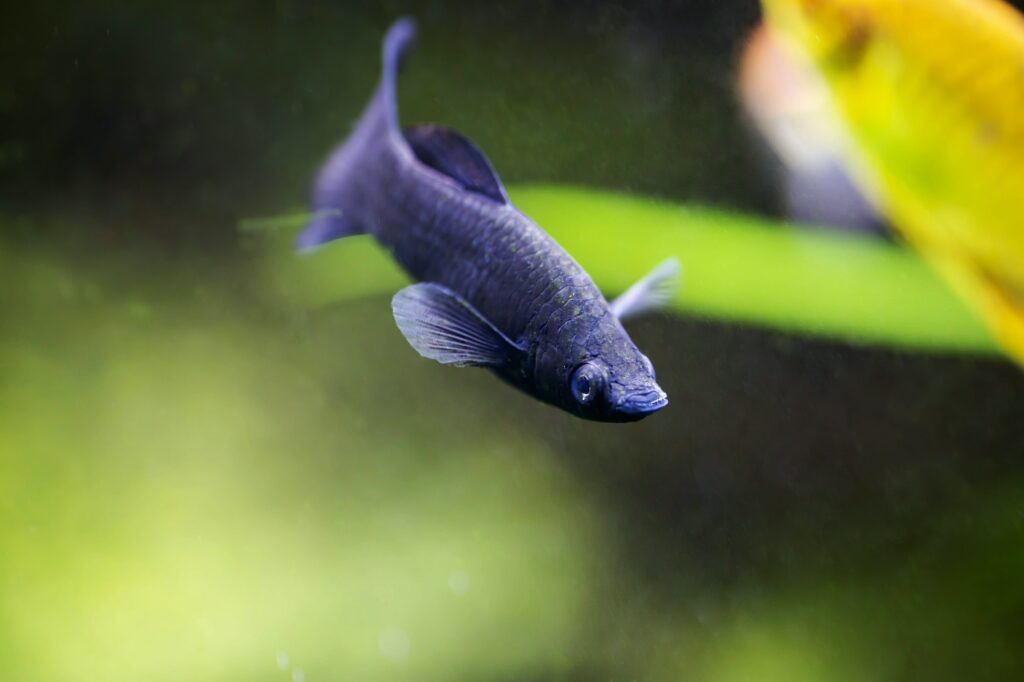
Within these common names, you’ll find several types of molly fish species. Here are a few of the most prevalent ones:
Shortfin Molly (Poecilia Mexicana)
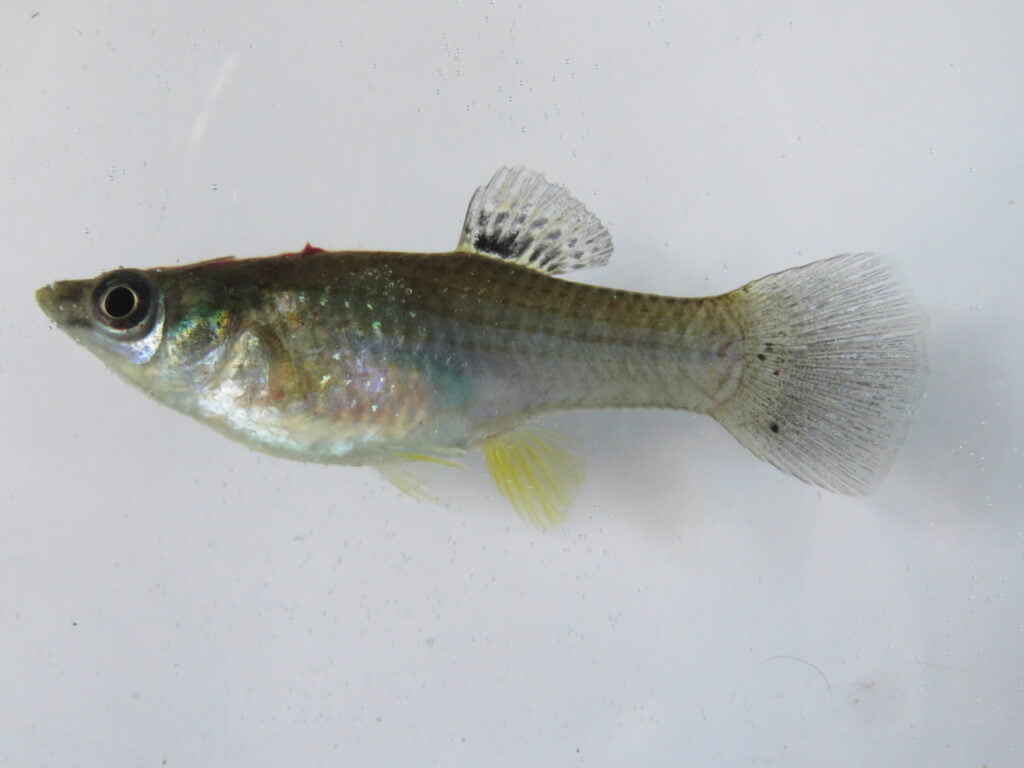
Known for its smaller fins compared to other mollies, it usually comes in silver, gold, or a wild-type coloration with a pattern of lateral stripes.
Sailfin Molly (Poecilia latipinna)
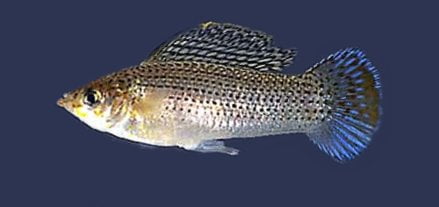
Recognized by the males’ large, sail-like dorsal fins. They come in a wide variety of colors and patterns, including black, white, silver, and Dalmatian.
Liberty Molly (Poecilia salvatoris)
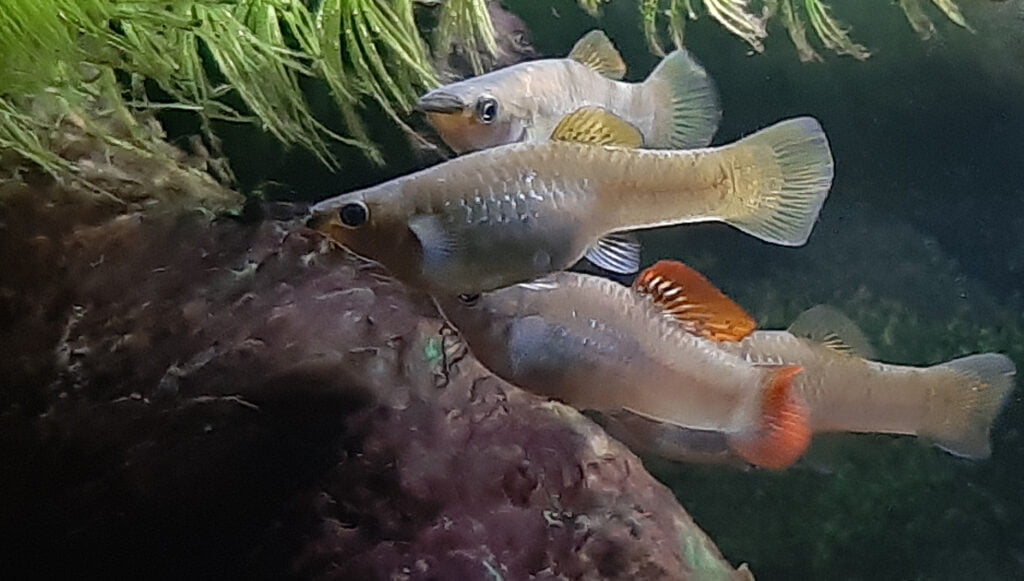
Known for their striking coloration, with males featuring an impressive gradient from green to orange to red, and females appearing silver with a green sheen.
Yucatan Molly (Poecilia velifera)
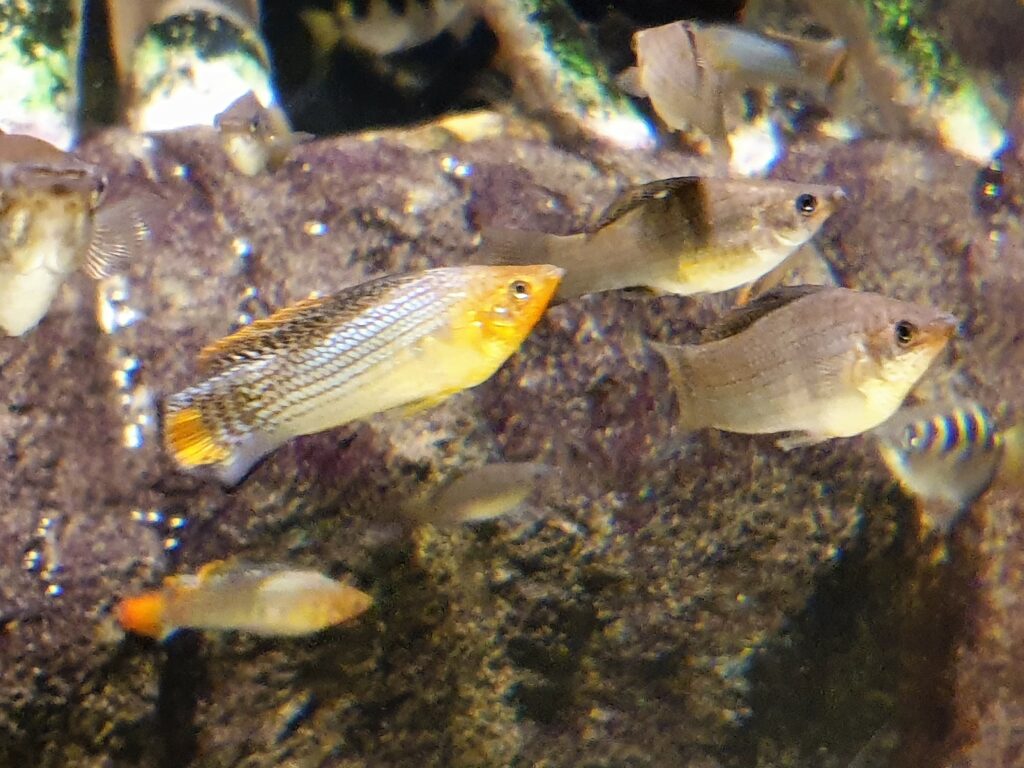
Known for their large sail-like dorsal fin and typically wild-type coloration, they closely resemble P. latipinna and can often be mistaken for them.
Each of these molly fish types has its unique characteristics, making them an interesting addition to your aquarium. And while prices can vary, mollies remain an affordable and highly rewarding choice for fish enthusiasts of all levels.
Ideal Tank Size and Water Parameters for Molly Fish
When setting up an aquarium for molly fish, it’s important to consider both the size of the tank and the water parameters to ensure a healthy and stress-free environment for your fish.
Tank Size
Mollies are active swimmers and appreciate ample space. A tank of at least 20 gallons is recommended for mollies, although larger is always better, especially if you plan to keep a group. For larger molly species like the sailfin molly, a 30-gallon tank might be a better starting point. Remember, the “one gallon per inch of fish” rule is a minimum guideline – more space is always better for the health and happiness of your fish.
Water Parameters
Mollies are freshwater fish but can also tolerate brackish water conditions. They’re relatively hardy but do best in specific water conditions:
- Temperature: Molly fish prefer warm waters, so aim to maintain a stable temperature between 72°F to 82°F (22°C to 28°C). A heater might be required to keep the temperature consistent, especially in cooler climates.
- pH Level: Mollies do best in slightly alkaline water. Aim for a pH level between 7.5 and 8.5. Regular testing can ensure that your pH remains within this range.
- Water Hardness: Mollies prefer hard water with a hardness between 10–25 dGH. If you live in an area with soft water, you might need to add a water conditioner to increase the hardness.
- Ammonia, Nitrite, Nitrate: Like all fish, mollies are sensitive to ammonia and nitrites, which should always be kept at 0 ppm. Nitrates should be kept below 20 ppm, and regular water changes can help maintain these parameters.
Always allow your aquarium to cycle before introducing mollies or any fish, as this will establish beneficial bacteria that help to maintain safe water parameters. Regular monitoring of your water parameters using an aquarium test kit is vital to prevent any issues before they become problems.
While molly fish are adaptable and can tolerate a range of conditions, they will be healthiest and happiest when their environment closely matches their natural habitat. By taking the time to set up your aquarium properly, you’ll ensure your mollies have a long, healthy, and happy life.
Lifespan and Full Size of Molly Fish
When properly cared for in a suitable environment, molly fish can lead a relatively long life compared to other small freshwater fish species. Their average lifespan tends to range between 3-5 years, although some can even live up to 7 years in exceptional circumstances.
The lifespan of a molly fish is influenced by several factors, including the quality of care, diet, water parameters, stress levels, and genetic factors. A well-maintained tank with optimal water conditions, a balanced diet, and a stress-free environment will contribute to your molly fish’s longevity.
As for the size of molly fish, this can vary depending on the species. On average, most mollies grow to about 3-4 inches in length. However, some types of mollies, such as the Sailfin Molly, can reach up to 5 inches or more in the right conditions.
The size of a molly fish can be influenced by factors such as diet, the size of their tank (fish often grow to fit their environment), and genetics. It’s also worth noting that males tend to be slightly smaller than females.
In conclusion, molly fish are relatively hardy fish that, when given proper care and a good environment, can bring you years of enjoyment. Their moderate size makes them suitable for a variety of tank setups, although as always, bigger is better when it comes to providing your fish with a comfortable home.
Natural Environment, Behavior, Habitat Preference, and Aquarium Decoration for Molly Fish
Natural Habitats of Molly Fish Species
Molly fish originate from the Americas, where they can be found in a range of environments from the Southern United States to South America. Mollies inhabit various types of freshwater and brackish water bodies, including slow-moving streams, ponds, marshes, and even some coastal areas. They are generally found in warm, slightly alkaline waters rich in vegetation.
Typical Behaviors to Expect
Mollies are peaceful, active, and social fish. They typically form loose groups or schools and are most active during the day. They love exploring their surroundings and are known to be surface dwellers, often seen swimming in the middle and upper levels of the tank. Although they’re generally peaceful, males can sometimes show mild aggression during breeding times or when they’re in a tank that’s too small.
Recreating Their Preferred Environment
To mimic the natural environment of molly fish in your aquarium, aim for warm water temperatures (72-82°F), slightly alkaline pH levels (7.5-8.5), and a level of hardness indicative of their brackish origins (10–25 dGH). Although mollies can live in a freshwater setup, they’ll thrive even better if there’s a small amount of marine salt in the water.
Aquarium Decorations to Mimic Their Natural Habitat
Molly fish enjoy well-decorated aquariums that give them plenty of places to explore and hide. Consider these elements when setting up your molly fish tank:
- Plants: Mollies enjoy aquariums rich in vegetation, mirroring their natural habitats. Live plants, like Java ferns or Anubias, are great choices. Not only do they provide cover, but they also help improve water quality by absorbing excess nutrients.
- Rocks and Driftwood: These can create hiding spots and replicate the complex environments found in their natural habitat. Make sure any rocks or driftwood are thoroughly cleaned and safe for aquarium use before adding them to your tank.
- Substrate: Mollies aren’t fussy about the substrate, but a darker substrate can make their colors stand out. Sand or fine gravel can be used.
- Open Swimming Space: While decorations are crucial, make sure not to overcrowd the tank. Mollies love to swim freely, so keep ample open space.
The goal is to replicate their natural environment as closely as possible. A well-decorated aquarium will not only meet the needs of your molly fish but will also create a more visually appealing display for you to enjoy.
Best Tank Mates for Molly Fish
Molly fish are generally peaceful and can coexist well with other similar-tempered fish species. When selecting tank mates for your molly fish, consider the size, temperament, and environmental needs of the potential tank mate. It’s also crucial to ensure that your aquarium is large enough to comfortably house all its inhabitants.
Here’s a list of some of the best tank mates for molly fish:
- Platies: Platies are known for their peaceful nature and vibrant colors. They share a similar livebearing reproduction process with mollies, making them compatible.
- Guppies: Guppies are small, lively fish that share similar water condition preferences with mollies, making them a good match.
- Swordtails: Swordtails are non-aggressive fish that share the livebearing characteristic with mollies. They are easy to maintain, making them a good choice for a shared tank.
- Tetras: Tetras are small and peaceful, making them a good fit for a community tank with mollies. Neon and cardinal tetras are often chosen for their vibrant colors.
- Corydoras Catfish: Corydoras catfish are peaceful bottom feeders that won’t compete with mollies for space. They also contribute to tank cleanliness.
- Ghost Shrimp: Ghost shrimp are small, peaceful creatures that contribute to tank cleanliness by eating leftover food and algae. They can cohabitate well with mollies.
- Cherry Shrimp: Cherry shrimp are non-aggressive, small, and add a splash of color to the tank. They also contribute to tank cleanliness, making them a good choice for a mollies tank.
- Amano Shrimp: Amano shrimp are slightly larger than cherry shrimp but maintain a peaceful demeanor and contribute to tank cleanliness.
- Zebra Danios: Zebra danios are known for their active swimming patterns but maintain a peaceful nature, making them compatible with mollies.
- White Cloud Mountain Minnows: These minnows are peaceful fish that thrive in similar water conditions as mollies, making them a good choice for a shared tank.
- Endler’s Livebearers: Endler’s are small, peaceful fish closely related to mollies. They can thrive in the same conditions, making them a good choice for a shared tank.
- Harlequin Rasboras: Harlequin Rasboras are peaceful fish that are easy to maintain, making them a good choice for a mollies tank.
- Dwarf Gouramis: Dwarf gouramis are peaceful, colorful fish that thrive in similar water conditions as mollies, making them a good choice for a shared tank.
- Honey Gouramis: Honey gouramis are peaceful fish that are easy to maintain, making them a good choice for a mollies tank.
- Bristlenose Plecos: Bristlenose plecos are peaceful bottom dwellers. Despite their larger size, they won’t disturb mollies.
- Otocinclus Catfish: Otocinclus are small, peaceful catfish that contribute to tank cleanliness, making them a good choice for a mollies tank.
- African Dwarf Frogs: These frogs are peaceful creatures that won’t disturb the mollies. They add a unique element to the tank.
- Nerite Snails: Nerite snails are peaceful creatures that contribute to tank cleanliness. They won’t disturb the mollies, making them a good choice for a shared tank.
- Mystery Snails: Mystery snails are larger than nerite snails but maintain a peaceful demeanor and contribute to tank cleanliness.
- Ramshorn Snails: Ramshorn snails are small, peaceful creatures that contribute to tank cleanliness, making them a good choice for a mollies tank.
It’s always a good idea to monitor new introductions to ensure all fish are getting along and to remove any individuals that show signs of aggression. By carefully selecting compatible tank mates for your molly fish, you can create a beautifully diverse and harmonious community aquarium.
Best Foods and Supplements for Molly Fish
Molly fish are omnivorous, meaning they eat both plant and animal matter, which should be reflected in their diet to ensure they get the necessary nutrients for good health and vibrant coloration.
Here’s what you can include in a balanced diet for molly fish:
Commercial Fish Food
High-quality flakes or pellets formulated for omnivorous fish can form the base of your molly fish’s diet. These foods are typically balanced to provide the right mix of nutrients.
Live and Frozen Foods
Mollies also appreciate small live or frozen foods like brine shrimp, bloodworms, and daphnia. These not only provide essential proteins but also stimulate the molly fish’s natural foraging behavior.
Vegetable Matter
Mollies require a significant amount of plant matter in their diet. This can be offered in the form of blanched vegetables like peas or spinach. There are also commercial foods available with spirulina, a type of algae, which can be beneficial for their digestive system.
Vitamin Supplements: Occasionally, supplementing your mollies’ diet with a specialized aquatic vitamin and mineral supplement can help ensure they’re receiving all necessary nutrients, particularly if you’re unable to provide a varied diet.
Moderation is key when feeding molly fish. Overfeeding can lead to health problems and pollute the tank. A general rule of thumb is to feed your fish only what they can consume in 2-3 minutes, once or twice a day.
Also, variety is crucial. Regularly rotating what you feed your mollies can help ensure they receive a broad range of nutrients and keep them interested in their food. With a varied, balanced diet, your molly fish will thrive and showcase their best colors.
Breeding Tips: Caring for a Pregnant Molly Fish
Mollies are livebearers, meaning they give birth to live young, rather than laying eggs. Breeding molly fish can be a rewarding experience, especially when you get to see the tiny fry swimming around your tank. Here’s how to care for a pregnant molly fish and ensure successful breeding:
Identifying a Pregnant Molly Fish
Determining whether your molly is pregnant is relatively straightforward. Female mollies often have a more rounded body than males, but when pregnant, their bellies will become noticeably larger and more distended. This is particularly obvious when viewed from above. Another sign is the “gravid spot” near her anal fin, which becomes darker during pregnancy.
Best Practices for Care During Gestation
Proper care for a pregnant molly involves a balanced diet, a stress-free environment, and careful monitoring:
- Diet: Pregnant mollies should be fed a balanced and nutritious diet to support her and the developing fry. This includes high-quality flake food or pellets, and regular servings of live or frozen foods for protein, and vegetable matter.
- Environment: A stress-free environment is crucial for a pregnant molly. Ensure the tank is spacious, clean, and free of aggressive tank mates. The water parameters should be maintained within the recommended range for molly fish.
- Separation: While mollies generally do well in community tanks, it can be beneficial to separate a pregnant molly as she nears the end of her gestation, as some fish may prey on the newborn fry.
Ensuring Successful Breeding and Rearing of Fry
Once the molly fish gives birth, there are a few steps to help ensure the survival and health of the fry:
- Protection: After birth, it’s essential to protect the fry either by removing them into a separate tank or providing enough hiding spots in the main tank. This is because mollies and other fish might eat the fry.
- Feeding: Molly Fry can eat finely crushed flake food, or you can purchase specialized fry food. Small live foods, like baby brine shrimp, are also an excellent choice for frying.
- Growing Out: As the fry grows and becomes too large to be eaten by adult fish, you can gradually reintroduce them into the main tank.
With proper care and attention, breeding molly fish can be a highly rewarding aspect of keeping these fascinating fish. It offers an amazing opportunity to observe the lifecycle of mollies and contribute to the growth and vitality of your aquarium community.
FAQs
How Many Mollies Can I Put in My Tank?
The number of mollies you can keep in your tank depends on the size of the tank and the species of molly fish. As a general guideline, you should have at least one gallon of water for each inch of fish. However, mollies are active swimmers and do appreciate more space, so it’s better to err on the side of a larger tank.
How Often Should I Feed My Molly Fish?
Feed your molly fish once or twice a day. Each feeding session should last around 2-3 minutes – provide only as much food as your fish can consume in this time. Overfeeding can lead to health problems for your mollies and water quality issues in your tank.
How Do I Maintain the Water Quality in My Molly Fish Tank?
Regular testing and water changes are key to maintaining water quality in your molly fish tank. Monitor the pH, ammonia, nitrite, nitrate, and hardness levels, and aim to do a 20-30% water change every week. Additionally, a good filtration system is vital to remove waste and keep the water clean.
How Often Should I Clean My Molly Fish Aquarium?
A thorough cleaning of your molly fish aquarium, including gravel vacuuming and algae scrubbing, should be done every 2-4 weeks. However, the frequency can depend on several factors, including the size of your tank, the number of fish, and the efficiency of your filtration system.
How to Identify If My Molly Fish Is Sick?
Sick molly fish may show various signs, such as lethargy, loss of appetite, changes in coloration, unusual swimming patterns, or visible spots or growths. Any changes in behavior or appearance should be monitored closely, as early detection is critical for effective treatment.
What Are the Common Diseases in Molly Fish and How Can I Treat Them?
Molly fish can be susceptible to various diseases, including Ich, fin rot, and fungal infections. Treatments will depend on the specific disease but often involve medication, increased water temperature, or salt baths. Always quarantine sick fish to prevent the spread of disease.
Can I Add Live Plants to My Molly Fish Aquarium? What Are the Benefits?
Yes, you can add live plants to your molly fish aquarium. Plants provide shelter and hiding spots for your mollies, help improve water quality by absorbing excess nutrients, and enhance the aesthetics of your tank.
What Behavior Does a Molly Fish Exhibit Before Death?
Before death, a molly fish may show signs like loss of appetite, lethargy, erratic swimming, or remaining near the bottom of the tank. These signs may indicate illness, so it’s essential to consult a vet or fish expert for advice.
How Long Can Molly Fish Go Without Food?
Molly fish can survive without food for up to two weeks. However, this is not recommended as it can cause stress and health problems. For short absences of a few days, an automatic fish feeder or vacation food blocks can be used.
Do Molly Fish Need a Heater in Their Tank?
Yes, mollies prefer warm water, so a heater is recommended to maintain a consistent temperature in the tank. The ideal temperature range for molly fish is 72-82°F.
Why Is My Molly Fish Not Eating?
Molly fish may stop eating due to stress, illness, poor water conditions, or unpalatable food. Check your water quality, observe for any signs of disease, and try offering a variety of foods to encourage your molly fish to eat.